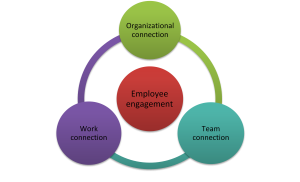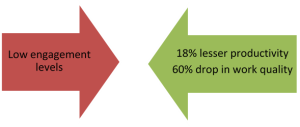
For a very long time now, employee engagement has been a hot topic of discussion in the field of modern HR. Most organizations make it a point to measure employee engagement rates using various tools regularly and take up measures to improve the engagement levels. Why is employee engagement so important in a workplace? What is the impact of employee engagement on employee productivity? How can an organization improve both its employee engagement and productivity rates?
Keep reading to learn more about the impact of employee engagement on productivity and dive deeper into the subject.
Learn how PossibleWorks can help you
Entrepreneurial competency is a set of skills and behaviour needed to create, develop, manage, and grow a business venture. It also includes the ability to handle the risks that come with running a business. Without a doubt, business owners and startup founders must possess most of the entrepreneur competencies to succeed.
Just like other types of competencies, there are different sub-categories here. The competencies could be technical, behavioural, attitude-based, or productivity-based.
Those with an entrepreneurial zeal need to play three prominent roles.
So the competencies for entrepreneurship are designed to help people perform in these roles effectively.
Employee engagement, in simple terms, is the connection an employee has with the organization, the team, and the work. Employee engagement measures an employee’s emotional and mental connections with the workplace. It measures how the employee feels about the organisation. The impact of employee engagement is intensive and holistic, and engagement levels affect the employee’s behaviour, attitude, ability, and commitment.
There are three broad connections employees may base their engagement levels on – organizational, team, and the actual job they do.

Depending on how employees feel about an organization, their engagement levels can range from highly engaged to disengaged. According to research, more than 92% of employers seem to agree that employee engagement levels affect the employee’s performance and productivity, and thereby, the success of the organization.
Very simply put, engaged employees work because they like what they do and are interested in doing it, not because someone asked them to or because they are paid for it.
An engaged employee is genuinely interested or engaged with the work and is more focused and motivated to see the results. As a result, productivity automatically gets optimized. Employee engagement and productivity go hand in hand. When the former is addressed, the latter gets taken care of.
A meta-analysis conducted among 1.4 million employees at the Gallup Organization revealed that employees with higher levels of engagement showed a 22% increase in productivity rate.
Another large-scale study analyzed the impact of employee engagement on productivity across 32,000 businesses. Compared to highly engaged employees, low-engagement folks had 18% lesser productivity. There was also a 60% drop in the quality of work, which means that you could expect more reworks, manual errors, and defects in the work of low-engaged employees.

The impact of employee engagement can be evident in other workplace factors apart from productivity. The turnover rate is a very important factor in measuring the overall success of an organization. All industries have an average turnover rate, which the organizations are expected better. Logically, a high turnover rate may mean that the employees are unhappy or disengaged.
In organizations with high employee engagement levels, the employee turnover rates have been measured to be 65% lower.
Consistently low absenteeism has also been observed in such high-engagement organizations. The organizations that recorded low employee engagement levels had a 37% higher rate of absenteeism.
Experts say that an engaged employee is more careful and adheres to all safety regulations. The impact of employee engagement affects workplace safety incidents. According to surveys, units with highly engaged employees report 41% fewer patient safety and quality incident cases when compared to units recording low engagement levels.
Do read our blog on the strategies to develop and sustain employee engagement at the workplace to get started.
Without a doubt, organizations are always on the lookout for engaged employees. As a result, they take all kinds of measures to improve overall employee engagement rates. Here are the reasons why organizations benefit from the positive impact of employee engagement on productivity.
Without a doubt, the impact of employee engagement is huge in all aspects of work. Conversely, disengagement, which occurs when employees are not engaged at work, can negatively impact productivity levels, employee satisfaction, and other vital factors needed for the organization’s overall success. So, here are some ways to steer clear of employee disengagement.
Spot disengagement early on
Make sure you spot some signs of disengagement early on and act on them to ensure it does not negatively affect employee productivity levels. Some of the signs to be aware of are:
Work on building a workplace culture
Employees who enjoy their work and like being with their peers are more engaged at work. So, take efforts to mould the workplace culture into something employees can relate to and hold close to their hearts.
Create specific and measurable goals and clear career paths
How would employees be engaged in something that’s vague or confusing? Make sure the goals set are specific and measurable. Employees should also know what is to be done exactly to achieve these goals. Such specificities help improve engagement levels and create a positive impact of employee engagement within the team.
Focus on effective reward and recognition processes
The impact of employee engagement depends on the R&R programs you have in place. The right rewards and recognition programs are one of the most impactful ways to prevent employee disengagement at work. Rewards and recognition helps employees feel wanted, valued, and cherished, and as a result, they are motivated to do better. Many surveys and statistics prove that good rewards and recognition program improves employee engagement levels drastically.
You can read our blog on the impact of employee recognition programs on employee engagement to understand this in detail.
Here are some stats for you.
PossibleWorks offers customized rewards and recognition tools that help promote peer-to-peer endorsements, automated nominations, and social recognition platforms within the organization. You will be able to upgrade your existing processes or create a new R&R system altogether with the help of our products.
The impact of employee engagement on productivity is huge and is something that needs to be taken seriously by organizations. Organizations that seem to struggle with employees’ skill-based and behavioural issues need to check the engagement rating and work on improving it. Reworking the rewards and recognition process is one way of improving engagement levels. Other ways may include building a better workplace culture, setting clear goals for the management and employees, and creating channels for transparent communication.
Employee engagement and productivity are both terms that directly affect the performance of the entire organization. So, do get in touch with us to know how best to improve these factors using cutting-edge tools and technology.
Are you using the right technology for your Recognition programs?